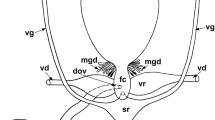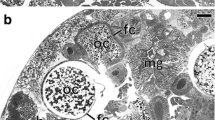Summary
In the insect Ulopa reticulata Fab. (Homoptera Auchenorhyncha), the egg envelopes are laid in the course of two stages. At first, closely apposed to the oocyte an inner layer is formed by stacking of closer and closer dense laminae, the origin and nature of which are discussed. Then an outer layer is deposited, as ordinary in the insects by the follicle cells which secrete a granular, at least partially proteinaceous substance.
Heriditary transovarian transmitted symbionts are to be found at the egg basis, in Ulopa reticulata. Their penetration occurs immediately after the beginning of the outer layer formation: the symbionts push back the inner layer which keeps them apart from the egg cytoplasm. The outer layer which is laid down, isolates also the symbionts from the follicle cells. The symbionts are, in this way, enclosed by the egg shell.
Résumé
Chez l'insecte Ulopa reticulata Fab. (Homoptera-Auchenorhyncha), les enveloppes de l'œuf se mettent en place en deux étapes. C'est d'abord au contact de l'ovocyte, la formation d'une couche interne constituée par l'empilement de plus en plus serré de lames dont la nature et l'origine sont discutées. Ensuite une couche externe se dépose de la manière habituelle aux insectes, à partir de matériel granulaire au moins en partie protéique, fourni par les cellules folliculeuses.
Des symbiontes à transmission héréditaire existent à la base de l'œuf chez Ulopa reticulata. Leur pénétration se produit dès le début du dépôt de la couche externe: les symbiontes repoussent la couche interne qui les sépare donc du vitellus de l'œuf; la couche externe se déposant ensuite les isole des cellules folliculeuses. Les symbiontes sont ainsi enfermés dans l'œuf.
Similar content being viewed by others
Bibliographie
Anderson, E.: The formation of the primary envelope during oocyte differentiation in teleosts. J. Cell Biol. 35, 193–212 (1967).
Beams, M. W., Kessel, R. G.: Synthesis and deposition of oocyte envelopes (vitelline membrane, chorion) and the uptake of yolk in the Dragonfly (Odonata: Aeschnidae). J. Cell Sci. 4, 241–264 (1969).
Buchner, P.: Endosymbiose der Tiere mit pflanzlichen Mikroorganismen. Basel, Schweiz: Birkhäuser 1953.
Cummings, M. R., King, R. C.: The vitellogenic stages of oogenesis in Drosophila melanogaster. J. Morph. 128, 427–441 (1969).
Favard-Sereno, C.: Rôle de l'appareil de Golgi dans la sécrétion du chorion de l'œuf chez le grillon (insecte, orthoptère). 6ème Int. Congr. Electr. Microsc., Kyoto, 553–554 (1966).
Gerrity, R. C., Rempel, J. G., Sweeny, P. R.: The embryology of Lytta viridana Le Conte (Coleoptera: Meloidae). II. The structure of the vitelline membrane. Canad. J. Zool. 45, 497–503 (1967).
Hopkins, C. R., King, P. E.: An electron microscopical and histochemical study of the oocyte periphery in Bombus terrestris during vitellogenesis. J. Cell Sci. 1, 201–216 (1966).
King, R. C., Aggarwal, S. K.: Oogenesis in Hyalophora cecropia. Growth 29, 17–83 (1965).
—, Koch, E. A.: Studies on the ovarian follicle cells of Drosophila. Quart. J. micr. Sci. 104, 297–320 (1963).
Koch, A.: Insects and their endosymbionts. Symbiosis II. Henry, S. M. (edit.) 1–96 (1967).
Ludwig, H.: Über die Eibildung im Thierreiche. Würzb. zool. Inst. Arb. 1, 287–510 (1874).
Muller, H. J.: Die Symbiose der Fulgoroiden (Homoptera-Cicadina). Thèse Stuttgart (1940).
Okada, E., Waddington, C. H.: The submicroscopic structure of the Drosophila egg. J. Embryol. exp. Morph. 7, 583–597 (1959).
Quattropani, S., Anderson, E.: The origin and structure of the secondary coat of the egg of Drosophila melanogaster. Z. Zellforsch. 95, 495–510 (1969).
Richards, J. G.: The structure and formation of the egg membranes in Nasonia vitripennis (Walker) (Hymenoptera, Pteromatidae). J. Microsc. (G.B.) 89, 1, 43–53 (1969).
Sweeny, P. R., Church, N. S., Rempel, J. G., Gerrity, R. G.: The embryology of Lytta, viridana Le Conte (Coleoptera: Meloidae). III. The structure of the chorion and micropyles. Canad. J. Zool. 46, 213–217 (1968).
Ulrich, E.: Etude des ultrastructures au cours de l'ovogénèse d'un poisson téléostéen, Le Danio, Brachydanio rerio (Hamilton-Buchanan). J. Microsc. 8, 447–478 (1969).
Author information
Authors and Affiliations
Additional information
Equipe de Recherche associée au C.N.R.S. ≪Cytologie Ultrastructurale≫, n∘ 129.
Rights and permissions
About this article
Cite this article
Hamon, C. Formation du chorion et pénétration des symbiontes dans l'œuf d'un insecte Homoptère Auchénorhynque, Ulopa reticulata Fab.. Z.Zellforsch 123, 112–120 (1972). https://doi.org/10.1007/BF00337677
Received:
Issue Date:
DOI: https://doi.org/10.1007/BF00337677




